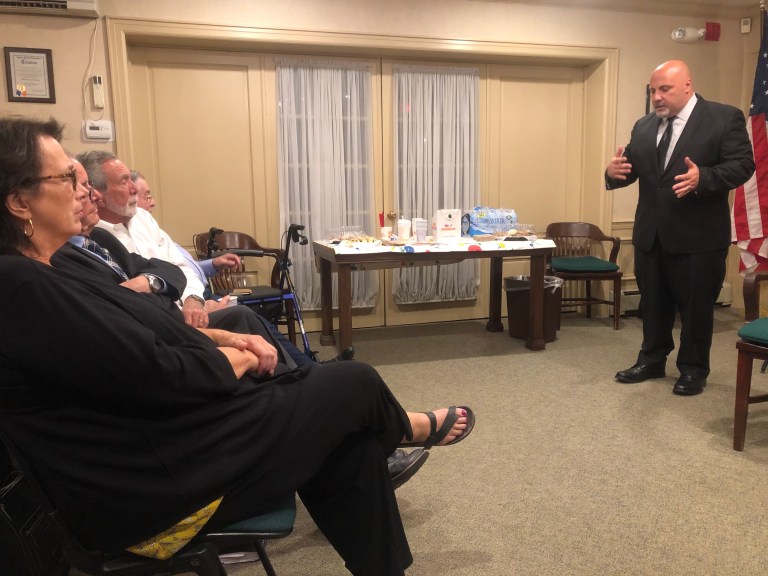
Officials from Great Neck villages met last Wednesday to discuss ways to revitalize the downtown area and find ways to spur improvements on Middle Neck Road.
“It’s clear to see that we all have the same goal here, turning Great Neck back into a place where we and our residents can be proud to call home,” said William Warner, mayor of the Village of Great Neck Estates.
He led the meeting of the Great Neck Village Officials Association, which represents nine villages, as the group’s president.
The meeting at the Great Neck Estates Village Hall was attended by Mayors Jean Celender (Great Neck Plaza), Pedram Bral (Great Neck), Susan Lopatkin (Kensington), Dan Levy (Saddle Rock), David Miller (Russell Gardens) and Steven Weinberg (Thomaston). Also attending were Assemblyman Anthony D’Urso (D-Port Washington), Barbara Berkowitz, president of the Great Neck school board, local architect Mark Stumer and others from around the community.
“One of the things that came up in a recent meeting with [North Hempstead Town Supervisor] Judi Bosworth was that not only did tons of people shop, and eat in Great Neck,” Warner said, “but people came here. It was a destination to come to. Now, neither of those things are true. People don’t want to shop here and people don’t want to stay here.”
Eric Alexander, director of Vision Long Island, which partners with communities across the island to promote economic revitalization and stability, said, “I think there’s a lot of effort that’s been done here for years.”
He talked about the shared aspects of the Great Neck community, such as roadways, public transportation, music and arts centers, and schools.
“Plenty of other villages and towns would kill to have the problems that you guys have,” he said. “As big as problems may seem for yourselves and your residents, there are other areas that are not in as good of a starting point for revitalization as Great Neck is currently.”
“I think that the main issue here, and common problem all of our villages face, is the dilapidation of Middle Neck Road,” said Bart Sobel, deputy mayor of the Village of Great Neck. “For an affluent community to be stuck with the lack of resources we currently face and the 20-something people that try to bottleneck progress, it’s increasingly difficult to try and revitalize.”
The most recent proposal for residential development in the downtown area was to build a four-story residential complex at 777 Middle Neck Road. It was discussed during the last Village of Great Neck board meeting on Sept. 17, and the presentation was met with frustration and unanswered questions by Great Neck residents.
Stumer, a principal architect for the past 25 years, followed Sobel’s comments by touching on the difficulties of business development in the area.
“The bottom line here is that we need developers, and they don’t want to come here,” he said. “The amount of time it has taken to put up just two 12-story apartment buildings in the past three years is ridiculous. You have to give them a reason to want to build here, don’t worry about the 20-something people who show up here and have nothing but complaining to do.”
Alexander challenged local officials to reach out to residential advocates to become more involved in board meetings that involve community revitalization.
The discussion also took up factors for and against new residential complexes specifically for millennials.
“Real estate taxes are one of the main factors why these millennials and young professionals can’t be here,” said Levy. “A lot of these people work either in the city or around here, but they just can’t simply afford to live here.”
“We want the mixed-income and affordable income for multiresidential areas,” said Celender, in response to Levy’s comments. “One of the other main issues is that it takes so much time to plan, agree upon and then construct these complexes that few people want to waste all that time.”
Officials of the meeting discussed the chicken-and-egg controversy over whether residences or businesses should be developed first. On one hand, some argued, once apartments are built, and rent is affordable for a younger crowd, downtown can be revitalized with more attractive storefronts.
“Once we bring in these people who can afford to pay these taxes,” Bral told the crowd, “then we can have a younger crowd start to come into our area, and have building supers be negotiable on the initial rent payments, to make it more affordable to pay. In turn, the residencies will be able to subsidize the commercial properties.”
On the other hand, and from what Alexander has noticed with past projects, it can be beneficial to build enticing storefronts to attract a younger crowd and families.
“What a lot of traditionalist areas such as Great Neck have to realize,” Alexander said, “is that, this isn’t, nor can it be, your father’s or grandfather’s downtown anymore. Putting restaurants, bars, commercial clothing stores, places for music and dance right by the train station has shown to make a positive impact on communities we’ve worked with in the past.”
Though no official date has been set yet, the association is hoping to meet once a month to keep working on revitalization and to have those who support it attend village meetings.






